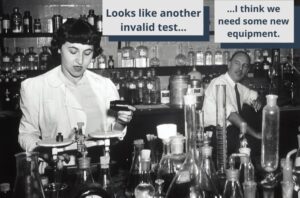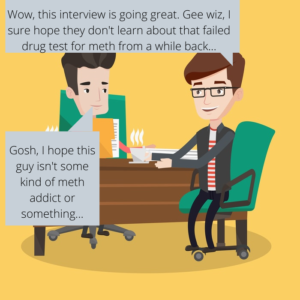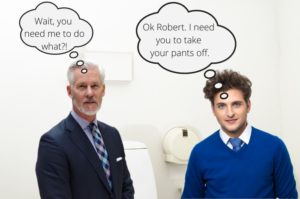Before getting started here, this post is not for people who enjoy reading dull legal text and federal regulations. If that is the case, just go read 49 CFR Part 382. It’ll be a field day.
However, if you would rather avoid such a chore, then you are in the right place. The whole point of this post is to clarify the regulation and highlight the important elements in as painless a way as possible.
This post will introduce the regulation and summarize subpart A.
49 CFR Part 382 Definition and Exposition
49 CFR Part 382 is the Federal Motor Carrier Safety Administration (FMCSA) regulations on “controlled substances and alcohol use and testing.” All this means is that it lays out the FMCSA policy on drugs, alcohol, testing, and training.
The purpose of 49 cfr 382 is to prevent accidents and injuries related to drugs and alcohol.
The Seven Subparts
The regulation itself is a dense body of work including seven subparts. The seven subparts are:
- Subpart A — General
- Subpart B — Prohibitions
- Subpart C — Tests Required
- Subpart D — Handling of Test Results, Records Retention, and Confidentiality
- Subpart E — Consequences for Drivers Engaging in Substance Use-Related Conduct
- Subpart F — Alcohol Misuse and Controlled Substances Use Information, Training, and Referral
- Subpart G — Requirements and Procedures for Implementation of the Commercial Driver’s License Drug and Alcohol Clearinghouse
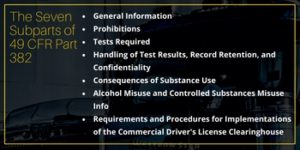
Subpart A — General
The first important element of Subpart A is the exceptions. They are:
- FTA employers and drivers
- Military personnel
- And farmers and farming equipment
If you fall under any of these categories, it may be worth your time to investigate further.
Then we learn that the testing procedures laid out in 49 CFR Part 40 apply to 49 CFR Part 382. Of course, 49 CFR Part 40 is just as extensive as part 382…(We will most likely be writing a summary of part 40 in the near future as well.)
Next comes the definitions, many of which are straightforward and obvious. But I will highlight three of the more important definitions here.
Commercial Motor Vehicle:
- The FMCSA has a very specific definition of a commercial motor vehicle
- First, the vehicle must be transporting people or property for the purpose of commerce
- Then the vehicle must have a gross combination weight or weight rating greater than 26,000 pounds (the higher figure between weight and weight rating is used here)
- And the towed unit weight or weight rating must be greater than 10,000 pounds (again the highest figure used)
- Or the vehicle must be transporting 16+ people including the driver
- Or the vehicle is transporting hazardous materials
Disabling Damage:
- For an accident to legally be called an accident, the following criteria must be met:
- The vehicle is not able to leave the scene of the accident after simple repairs attempted
- Or the vehicle could be driven away, but not without further damaging it
A few more things that would not be considered an accident: tire damage, even when spare not available; headlight/taillight damage; or damage to turn signals, horn, or windshield wipers.
Safety-Sensitive Function:
- Whenever the driver is:
- At the shipping facility, plant, supplier, whatever it may be, waiting to dispatch
- Inspecting equipment
- Driving
- On a vehicle, with the exception of sleeping
- Repairing a vehicle
- Loading, unloading, supervisor or managing the loading or unloading of a vehicle
Then the regulation explains that it should pre-empt State and local regulation, with the exception of criminal law.
And part 382 does not prevent employers from adding their own additional drug and alcohol policy. For many companies, part 382 is merely a baseline.
And employers must notify drivers when the drug test is required by part 382 as well as when it is not. Employers can’t pretend that a drug test is legally required when it is not.
Then it explains that the process for standing down an employee awaiting drug and alcohol test results is actually very difficult. If you need to stand an employee down, then you may need to contact the FMCSA directly.
And finally, 49 cfr part 382 explains that an employee who admits to alcohol or drug use is exempt from the return-to-duty process. Of course, the correct steps must be taken, and the employee cannot be using the confession to get out of a test. If you need to know the exact parameters for an allowed admission, click the link.
49 CFR Part 382 Subpart B: Prohibitions
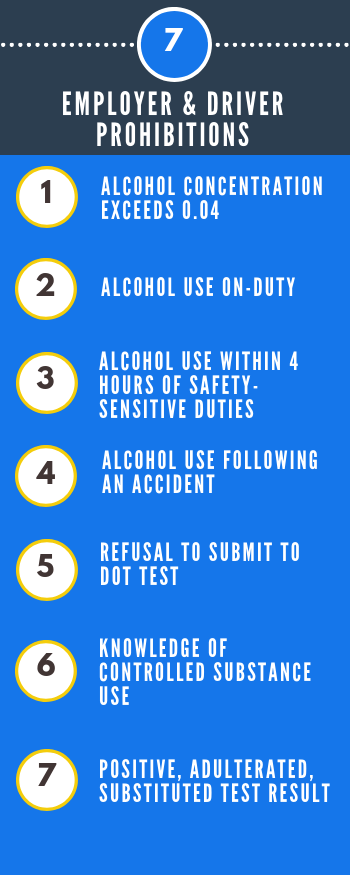
Subpart B – Prohibitions – consists of seven different prohibited actions revolving around controlled substances. These prohibited actions pertain to both drivers and employers.
Drivers cannot perform safety-sensitive functions in the following instances:
- Their alcohol concentration is greater than or equal to 0.04
- They are using alcohol while on duty
- They have used alcohol within 4 hours of performing safety-sensitive duties
- They are either within 8 hours of an accident or have not yet taken the post-accident alcohol test, whichever ends first
- They have refused to submit to any of the six DOT testing situations
- They have used any Schedule 1 drugs (I’d say for 99% of the population, the names of those drugs could just as well be in a foreign language, and we wouldn’t even know…)
- They have a positive, substituted, or adulterated drug test on record
Also, before going into detail on each of these instances, employers may not allow a driver to work if they have actual knowledge of any of these prohibitions.
Okay, so let’s explain each of the instances above:
Alcohol Concentration > 0.04
The reasoning behind some of the prohibited actions is pretty obvious, and an alcohol concentration exceeding 0.04 falls under that category.
Don’t perform safety-sensitive duties when you are legally drunk!!!
Using Alcohol While On-Duty
Another prohibition falling under the category of duh, using alcohol while on-duty is a dubious proposition. Just don’t do it, and if you are a supervisor or employer, don’t allow your drivers to do it.
Alcohol Use Within 4 Hours of Safety-Sensitive Duties
If a driver has used alcohol within 4 hours of performing their safety-sensitive duties, then they could still have alcohol in their system when they start their work.
Also, I say “safety-sensitive duties” here because that involves more than just driving. It also includes being on-site getting ready to drive, servicing any commercial motor vehicle, and any time on-site post driving. Then when faced with the challenge of a driving under influence accusation, it’s critical to engage a lawyer who is well-versed in these matters. The right legal counsel will not only help to mitigate the charges but also ensure that your case is presented in the best possible light. Explore expert driving under influence defense help for more information.
8 Hours Post Accident Or Until Getting Post-Accident Alcohol Test
Supervisors, DERs, and employers need to know whether alcohol was involved in the accident. After an accident, if a driver drinks prior to getting an alcohol test, there is no way to determine whether alcohol was involved.
Also, after 8 hours any alcohol will have likely passed through the driver’s system, so doing a test at that point is not terribly useful.
So after 8 hours or after an alcohol test is performed, the driver is free to get a little rowdy. But not before!
If the driver does drink before the test, or does not make themselves available for a test, that driver is liable.
If the driver makes themselves available for testing and yet the DER does not do the test within 8 hours, the DER has a whole bunch of paperwork explaining why the test didn’t happen.
Alcohol needs to be ruled out of the possible causes of the accident.
Refusal To Submit To DOT Test
Any refusal to do a DOT test is equivalent to a verified positive result. It automatically requires the driver to go through the DOT return-to-duty process before continuing with safety-sensitive duties.
If a driver refuses to test, they are barred from safety-sensitive functions.
Also, before moving on to the next point, here are the six DOT testing situations:
- Reasonable Suspicion
- Pre-Employment
- Post-Accident
- Random
- Return-To-Duty
- Follow-Up
Any refusal of these tests disqualifies a driver from their work.
Schedule 1 Drug Use
If a driver has used any Schedule 1 drugs, which are listed in 21 CFR 1308.11, they are barred from performing safety-sensitive duties.
These drugs mostly fall under the following classes:
- Marijuana
- Cocaine
- Amphetamines
- Opiates
- PCP
Obviously, if they have used any of these drugs, they are not fit to perform any function in their typical job criteria.
And if an employer has knowledge of a driver’s drug use, they must stop that driver from working.
Also banned are the non-Schedule 1 drugs, with one exception: if a licensed medical practitioner prescribes the drug to the driver, with full knowledge of the driver’s history and occupation. The medical practitioner must also ensure that it will not adversely affect the driver’s ability to do their job.
Notice how there isn’t any time criteria relating to the use of these drugs. That is because if a driver has used these drugs at all, that bars them from safety-sensitive duties.
Of course, in practice there’s no way to ban Driver Ricky from safety-sensitive duties because he smoked pot ten years ago. But let’s just say this: if you’re a driver don’t go blabbering to your supervisors and employers about your weed smoking hippie phase when you lived in Berkeley.
Positive, Adulterated, Substituted Test Result
If the driver has a verified positive, adulterated, or substituted test result, that driver cannot perform safety-sensitive duties (i.e., their job) until completing the DOT return-to-duty process.
Adulterated and substituted test results are considered refusals to test. And as explained in the refusal to test section, that also bans the driver from safety-sensitive duties until completing the DOT return-to-duty process.
Basically, if there is evidence of drug use in the form of a positive test result, the employer cannot allow the driver to work. The driver must first complete the return-to-duty process before reinstatement.
The Employer’s Major Responsibility
Employers must require drivers to go through the DOT return-to-duty process after any breach of these prohibitions.
49 CFR Part 382 Subpart C: Tests Required
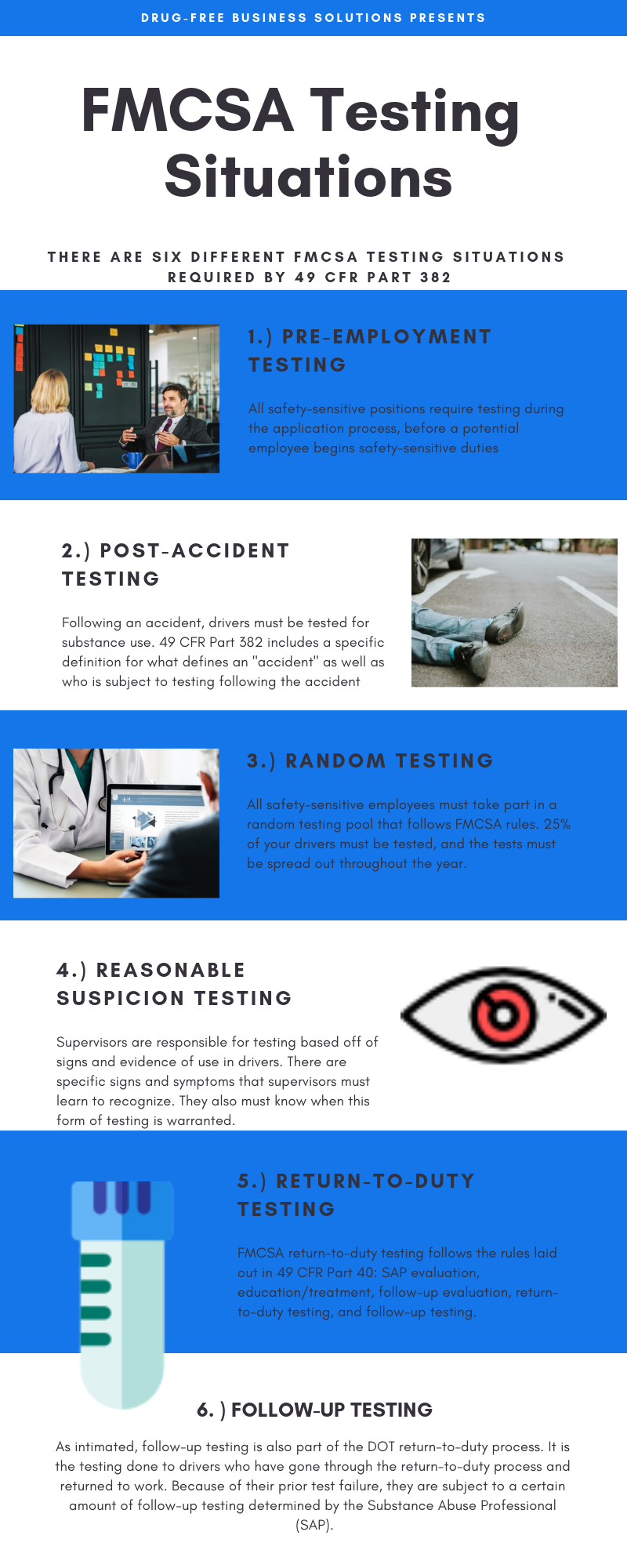
There are six FMCSA testing situations as detailed in 49 CFR Part 382. They are as follows:
- Pre-Employment Testing
- Post-Accident Testing
- Random Testing
- Reasonable Suspicion Testing
- Return-To-Duty Testing
- Follow-Up Testing
Pre-Employment Testing
No driver can begin performing safety-sensitive duties until he or she has received a verified negative drug test result from an MRO or C/TPA.
The exception to this rule is if the applicant has been part of a controlled substances testing program within the past 30 days from the time of application and was either tested in the last six months or had been part of the controlled substances program for the past 12 months prior to their application.
Also, the prior employer should have no record of any violations on the applicant.
And pre-employment alcohol testing is optional.
Post-Accident Testing
Post-accident testing is drug or alcohol testing done after an accident, as defined by the FMCSA.
You must test drivers post-accident for alcohol if there is loss of life or if a driver is issued a citation within 8 hours of the accident.
You must test drivers post-accident for drugs if there is loss of life or if a citation is issued to the driver within 32 hours of the accident.
It is important to be timely with FMCSA post-accident testing. You must test for alcohol within 8 hours of the accident. But if you test more than two hours after the accident, even when still less than 8 hours, you must provide paperwork explaining the delay.
If you wait longer than 8 hours, you cannot do an alcohol test.
For drug testing, you have 32 hours to complete the test. If you don’t complete the test within 32 hours, you must provide paperwork explaining why the test wasn’t completed.
After 32 hours, you must cease efforts to test for drugs.
Random Testing
Random testing is when all drivers are placed in a pool and randomly selected periodically, without any prior notice, for drug and alcohol tests.
All drivers must partake in a random drug testing program.
As of March 5, 2019, the FMCSA random testing rates are as follows:
- 10% of the average number of drivers in your program must be tested for alcohol
- 25% of the average number of drivers in your program must be tested for drugs
Reasonable Suspicion Testing
Reasonable suspicion testing is when a supervisor orders a driver to take a drug or alcohol test based on suspicion that they have been using a controlled substance.
First, for supervisors to require reasonable suspicion alcohol or drug tests, they must receive training meeting the requirements set by the FMCSA.
Then, their observations must be:
- Specific: they must be able to pinpoint the things that tip them off to substance use — eyes, smell, breath, gait, disheveled appearance, speech slurred, etc.
- Contemporaneous: they must be made in the present situation, not last week or even yesterday
- Articulable: they must be written down in an understandable way
Also, the observations must be made regarding the driver’s appearance, behavior, speech, or body odors.
Alcohol testing determinations must be made when the driver is about to perform, performing, or just completing safety-sensitive duties. It is not illegal to drink on your own time.
And drug testing determinations can be made even if the supervisor suspects the signs they observe are related to chronic use or withdrawal.
Return-To-Duty Testing
The rules for the return-to-duty testing process are highlighted in 49 CFR Part 40 Subpart O.
A driver must receive a verified negative result to return to safety-sensitive duties.
Follow-Up Testing
A follow-up test is a test given to a driver who has returned to safety-sensitive work following a failed DOT drug or alcohol test.
The substance abuse professional determines the follow-up plan for drivers, including the number of follow-up tests required.
Subpart D — Handling of Records, Test Results, and Confidentiality
Subpart D discusses the administrative aspects of a DOT drug and alcohol testing program. It discusses what records you must retain, in what form, and for how long.
It also covers the necessary steps to maintain confidentiality as well as instances where you may release records.
The Types of Records
You must maintain records for the following things:
- Collection process: so any records or notes you have regarding the process of breath or urine collection
- Test results: whether negative, positive, refusal, or cancelled, you must retain each for a period of time, of which we will soon discuss
- Other violations of Part 382: If any other violations of Part 382 occur, you must retain record of them
- Evaluations: when an SAP, counselor, or doctor evaluate a driver after a drug/alcohol test failure, you must keep record of this evaluation
- Education/Training: you must maintain record of the education and training you provide to supervisors, drivers, and any other employees regarding your DOT drug and alcohol testing program.
- Any other administrative records related to testing: a couple of examples would be agreements with collection sites or C/TPAs or your company’s drug and alcohol testing policy.
Records Retention
Then, Subpart D continues to explain how long you must retain each record.
You must retain the following items for a minimum of 5 years:
- Alcohol test of greater than or equal to 0.02
- Positive drug test results
- Refusals to test documentation
- Driver evaluations and referrals
- Calibration documentation (this refers to alcohol breath testing machines)
- Previous year DOT testing program summary: the format and structure for this is explained in 49 CFR part 40 in 40.26 and appendix H
And you must retain the following items for a minimum of 2 years:
- Collection process records
Then you must retain negative/cancelled test results for a minimum of 1 year.
Finally, you must maintain education and training records of employees performing safety-sensitive functions for a minimum of 2 years after they stop performing those functions for your company.
Confidentiality
Subpart D continues to explain that all of these records must stay confidential. And it also explains exceptions and exemptions to this confidentiality:
- The driver is entitled to copies of records pertaining to their testing results
- Employers must be able to grant access to all facilities used to overseeing authorities, for example the DOT: if the employer uses a collection site, they must be able to give testing authorities permission to go to that collection site
- Employers must be able to provide their records to authorities when requested
- They must provide records to the National Transportation Safety Board when part of a crash investigation
- Written requests by subsequent employers of drivers
- Lawsuits, grievances, and administrative proceedings when they are initiated by the employee or individual
- When employee gives written consent to release records. But in this case, it must be a specific individual as well as specific records
MRO Notifications
The MRO must notify employers of test results in a particular manner. Part 382 refers here to 49 CFR Part 40 Subpart G.
MRO or C/TPA Record Retention
MRO’s and C/TPA’s must retain the same records and for the same time periods as employers:
- 5 years for positive test results
- 1 year for negative/cancelled tests
- And cannot release info on a drive to anyone without written consent from that driver
Employer Notifications
Employers are required to take care of the following notifications as part of their DOT drug and alcohol testing program:
- Pre-employment Drug test results when requested by applicant
- Random, reasonable suspicion, and post-accident drug test results when positive
- DER must attempt to contact driver to let them know to reach out about their test results to the MRO, when MRO cannot reach driver
- DER must then immediately let MRO know that driver has been contacted so the MRO knows after 72 hours to go ahead with the test results
Inquiries To Previous Employers
As part of the pre-employment application process for safety-sensitive positions, employers must reach out to former employers of the driver in the past 3 years in regards to alcohol and drug use.
Also, they must reach out to companies the pending driver has applied and done pre-employment testing for in the past 3 years.
The FMCSA Drug and Alcohol Clearinghouse
Starting in 2023 (for now at least…), since this pre-employment verification process is anything but failsafe, the FMCSA will begin using a Clearinghouse for employers to log drug and alcohol testing data for all drivers.
So the pre-employment verification process will involve checking the clearinghouse. There will be no need to reach out to other employers.
Subpart E — Consequences of Violations for Drivers
Subpart E is a short one, covering just a few points.
Cannot Perform Safety-Sensitive Functions
First, it states that if a driver has violated any of the rules described in Subpart B, they cannot do safety-sensitive functions. For your convenience, the prohibitions in Subpart B are below:
- Alcohol concentration greater than or equal to 0.04
- On-duty alcohol use
- Pre-duty alcohol use (within 4 hours)
- Alcohol use following an accident (until after post-accident testing done or 8 hours pass)
- Any refusal to test
- 5-panel drug use
So if a driver has committed any of the above violations, the employer cannot allow them to perform safety-sensitive functions.
How a Driver Can Return To Safety-Sensitive Work
But they are not banned from safety-sensitive functions forever. Subpart E then refers to 49 CFR Part 40 Subpart O. If you remember, this is the set of regulations that covers all DOT drug and alcohol testing programs.
This subpart, Subpart O, pertains to the substance abuse professional rules as well as the DOT return-to-duty rules.
The DOT return-to-duty rules basically say that a driver who violates the rules must meet with a SAP for evaluation. Then the SAP will create a treatment/education plan for the driver, and the driver must follow through with that plan.
Once the driver does, she can return to safety-sensitive functions after passing a return-to-duty test.
Another Alcohol-Related Stipulation
Subpart E continues on to explain that a driver who has a BAC higher than 0.02 but lower than 0.04 should be removed from safety-sensitive functions. Then, that driver should be held out for a minimum of 24 hours after the test was administered.
At the same time, employers cannot take action against the driver. Having a BAC below 0.04 is not a violation. Their 24 hour removal is a precaution.
Subpart F — The Requirements for Information, Training, and Referrals
49 CFR Part 382 Subpart F covers a few topics. First, it discusses the information employers must provide employees with regard to these regulations as well as their DOT policy.
Then it covers the training that employers must provide supervisors of safety-sensitive drivers.
And finally, it discusses the referrals of employees who violate that DOT policy.
The Information Employers Must Provide Drivers
Each driver must get a copy of informational materials before the start of DOT drug and alcohol testing and of performing safety-sensitive functions.
These materials must cover at least the following:
- The person in the company who can answer a driver’s questions about their DOT testing policy
- The different categories of drivers subject to the DOT testing policy – basically the different safety-sensitive positions employed by the company
- A good explanation of what aspects of their job are considered safety-sensitive – drivers need to know when they must comply with this part
- Prohibited driver conduct (Subpart B)
- The DOT testing situations (Subpart C)
- DOT drug and alcohol testing procedures: it should also discuss the safeguards built into the process to protect the driver, which is mostly described in 49 CFR Part 40
- The requirement to submit to drug and alcohol testing that is in accord with these rules
- Consequences for violations described in Subpart B: removal from safety-sensitive duties until completing the DOT return-to-duty process
- Consequences of a BAC greater than or equal to 0.02 but less than 0.04: removal from safety-sensitive work for 24 hours
- Information on drugs and alcohol:
- Effects on health
- Signs and symptoms of substance abuse problems
- Methods for intervening when substance problem is suspected
- Violations will be reported to the drug and alcohol clearinghouse, which is essentially a database for CDL drivers that tracks DOT violations
Our FMCSA employee education program meets all of the requirements listed above and is a good example of the type of materials employees must receive before enrolling in the testing program and beginning safety-sensitive functions.
If you’re a little wary of having to put together materials yourself, or question whether the materials your company currently provides meet the requirements, check out our education program. And see what it can offer.
Training for Supervisors
All supervisors of safety-sensitive drivers must receive 60 minutes of training on alcohol misuse as well as 60 minutes of training on controlled substances use.
The training will help supervisors determine whether reasonable suspicion exists for drug or alcohol testing.
Just as with the employee education, our FMCSA supervisor training meets the requirements described here. And it prepares your supervisors to make good reasonable suspicion decisions.
Referrals in the Instance of a Violation
The subpart here refers to 49 CFR Part 40, Subpart O. This subpart covers the DOT return-to-duty process.
Conclusion
Subpart A sets the stage for 49 cfr part 382. Subpart B then discusses the prohibited driver and employer actions. Subpart C covers the six FMCSA testing situations. Subpart D then highlights the administrative proceedings of your testing program. And Subpart E explains the consequences for violations. Finally, Subpart F discusses the information and training employers must provide to drivers and supervisors.
And while it doesn’t make for the most interesting read, it contains vital information for you and your company.
We will cover the final subpart – Subpart G – in another post. Subpart G discusses the FMCSA CDL drug and alcohol clearinghouse procedures.
Also, if you have a story about how knowing the FMCSA regulations has helped you in the line of duty, we would love to hear about it in the comments section. Always nice to hear about preparation and due diligence paying off.




